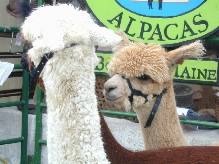|
Yarns
Reviews
 More articles
More articles
Shops
Links

Related info
New this week
Subscribe!
Tell a friend
Home


|
|
|

Fiber Profile:
Alpaca
 
It's a camel! It's an ostrich! What is that odd-looking animal, anyway?
It's an Alpaca!
When they first started appearing in the U.S. 20 years ago, alpacas were often used as "novelty" animals in petting zoos. If they were poked, pinched, or prodded one too many times, the animals resorted to a defense mechanism they are now known for: spitting.
Don't be mislead, however. If left to their own devices, alpacas are mellow, gentle animals that spend their days grazing and taking in the fresh air. Spend the afternoon watching these animals and you'll be convinced -- as am I -- that they're truly remarkable creatures, deserving all of the attention they're getting.
South American Beginnings
While Merino sheep and angora goats have their roots in the Middle East and Europe, the alpaca is distinctively South American. The Incas prized alpaca fiber, used it for clothing, and included the animal in many of their religious ceremonies.
When the Spanish conquistadors arrived, they were too enamored with Merino to see any value in alpacas, so they remained undiscovered by Europeans for many more years.
Europeans Catch On
In the mid-1880s, Sir Titus Salt of Yorkshire, England, began exploring the properties of alpaca fleece. He produced textiles from alpaca fiber and introduced them across Europe.
Despite Salt's efforts, however, the alpaca textile industry never left South America because of strict animal exportation regulations imposed by various South American governments.
Today, the alpaca industry is centered in Arequipa, Peru. Almost 99% of the world's alpaca population (some three million animals) is still found in Peru, Chile, and Bolivia.
Why Alpaca?
Alpacas make great economical and environmental sense. While wool continues to decline in value, alpaca earns a high premium. The animals need very little land on which to graze; they're generally healthy and trouble-free; they have pleasant temperaments; and they produce a fiber that's softer than cashmere.
When we first published this article, there was no commercial spinnery in the United States equipped to process alpaca for large-scale commercial yarn companies, so many breeders pooled their fleeces into collective orders and sent them to South America to be processed. Fortunately, this has changed in recent days. Still, in the case of larger manufacturers, almost all of them get their fiber straight from South America.
As the number of animals and commercial alpaca spinneries in the United States increase, the price of alpaca fiber is sure to drop. For now, it remains at a premium.
 Read about our road trip to Fiber Fields Alpaca Farm. Read about our road trip to Fiber Fields Alpaca Farm.
 Talk about alpaca in our forums Talk about alpaca in our forums
Read Reviews of Alpaca Yarns
 Adrienne Vittadini Eva Adrienne Vittadini Eva
 Adrienne Vittadini Natasha Adrienne Vittadini Natasha
 Blue Sky Alpaca Blue Sky Alpaca
 Catalina Chunky Baby Alpaca Catalina Chunky Baby Alpaca
 Classic Elite Inca Alpaca Classic Elite Inca Alpaca
 Classic Elite Wings Classic Elite Wings
 Debbie Bliss Alpaca Silk Debbie Bliss Alpaca Silk
 Fibreworks Overview Fibreworks Overview
 Filatura di Crosa Muschio Filatura di Crosa Muschio
 GGH Alaska GGH Alaska
 Goddess Yarns Julia Goddess Yarns Julia
 Jaeger Alpaca Jaeger Alpaca
 Jaeger Luxury Tweed Jaeger Luxury Tweed
 Knit Picks overview Knit Picks overview
 Noro Transitions Noro Transitions
 Plymouth Baby Alpaca Brush Plymouth Baby Alpaca Brush
Additional Links
 New England Alpaca Owners and Breeders Association New England Alpaca Owners and Breeders Association
 Alpaca Owners and Breeders Association Alpaca Owners and Breeders Association
 Alpaca and Llama Show Association Alpaca and Llama Show Association
 The Alpaca Registry, Inc. The Alpaca Registry, Inc.
 NEWAIM Farm NEWAIM Farm
Previous Reader Comments
"I would like add an alpaca comment. There is a mill in the US that handles large quantities of alpaca. The New England Fiber Pool has fiber spun and products made each year in the USA. See their website. I love reading the Review each week especially the poll. I love my alpaca and thanks for the link at the end of the article!" Nancy, NEWAIM Farm, 9/5/03
"I wasn't familiar with alpaca until I attended the Wool Market in Estes
Park. I'm hooked. It's a beautiful, rich fiber. So soft. And the animals
are wonderful. I'm not able to wear wool. It just bothers me. I purchased
some alpaca at the show from the Alpaca Fiber Cooperative of N. America.
I've been knitting with it and the finished product is great. VERY warm.
No one in my area (Missouri) knows about alpaca, so now everyone wants me
to knit them alpaca sweaters. It's my fiber of choice for winter items.
It makes me want to start spinning, since there are not too many places to
buy the yarn from." wjmlh, 9/10/2001
"Thanks for re-running your article on Alpaca. I live near several Alpaca
farms in Colorado. My favorite is Serendipity Fiber Arts center; their web
site is www.fiberartscenter.com, I believe. The farm is owned by Ron and
Marie Hinds, and they offer alpaca yarn at VERY good prices, as well as
fiber for handspinners. There are also some other alpaca breeder's
associations they can inform you of. I know the acronym for one is ARBA,
but I don't know what that stands for exactly." Joy, 9/7/2001
"I work at Ohio Valley Natural Fibers. I process tons of Alpaca. We do spin
Alpaca/wool yarn. The Alpaca fiber itself is to long to make a 100% yarn. I think it would be to hot by itself. We process most Alpaca into rovings for Handspinners, also felting batts. I myself am a handspinner and I have spun some 100% Alpaca. Alpaca is a beautiful fiber, so many gorgeous colors. Such cute animals!"
R. Isaac, 11/03/2000
|
|